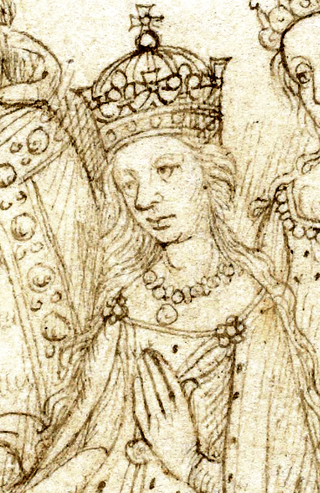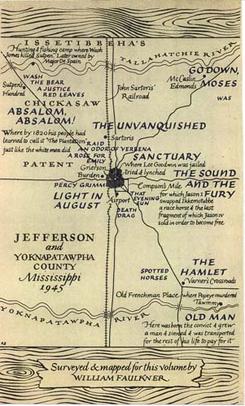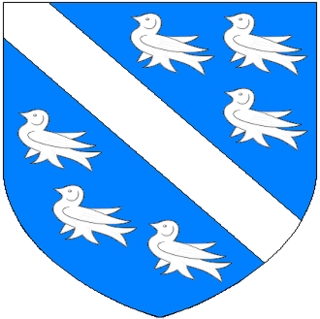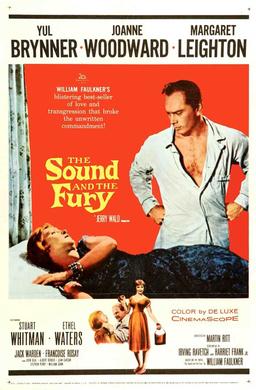
Absalom was the third son of David, King of Israel with Maacah, daughter of Talmai, King of Geshur.

William Cuthbert Faulkner was an American writer known for his novels and short stories set in the fictional Yoknapatawpha County, based on Lafayette County, Mississippi, where Faulkner spent most of his life. A Nobel laureate, Faulkner is one of the most celebrated writers of American literature and often is considered the greatest writer of Southern literature.

Catherine of Valois or Catherine of France was Queen of England from 1420 until 1422. A daughter of Charles VI of France, she was married to Henry V of England and was the mother of Henry VI. Catherine's older sister Isabella had also been a Queen of England as the child bride of Richard II. Catherine's marriage was part of a plan to eventually place Henry V on the throne of France, and perhaps end what is now known as the Hundred Years' War, but although her son Henry VI was later crowned in Paris, this ultimately failed.

In Greek mythology, Niobe was a daughter of Tantalus and of either Dione or of Eurythemista or Euryanassa. Niobe was the wife of Amphion and the sister of Pelops and Broteas.

The Sound and the Fury is a novel by the American author William Faulkner. It employs several narrative styles, including stream of consciousness. Published in 1929, The Sound and the Fury was Faulkner's fourth novel, and was not immediately successful. In 1931, however, when Faulkner's sixth novel, Sanctuary, was published—a sensationalist story, which Faulkner later said was written only for money—The Sound and the Fury also became commercially successful, and Faulkner began to receive critical attention.
In social psychology, propinquity is one of the main factors leading to interpersonal attraction.

Yoknapatawpha County is a fictional Mississippi county created by the American author William Faulkner, largely based upon and inspired by Lafayette County, Mississippi, and its county seat of Oxford. Faulkner often referred to Yoknapatawpha County as "my apocryphal county".
The Compson family is a fictional family created by American author William Faulkner for use in his novels and short stories. A once prominent family in Yoknapatawpha County, Mississippi, the family began to fall on hard times in the twentieth century. Principally depicted in The Sound and the Fury and in its appendix, they also make appearances in Absalom, Absalom! and stories such as "That Evening Sun". The family name is also referred to briefly in the opening chapter of Requiem for a Nun. Faulkner traced their genealogy from 1699 to 1945.
Thomas Sutpen is a focal character of William Faulkner's 1936 novel Absalom, Absalom! Sutpen arrives in Faulkner's imaginary Yoknapatawpha County, Mississippi, in the 1830s and establishes a 64,000-acre (100-square-mile) plantation, Sutpen's Hundred, in an attempt to create his own dynasty. It is eventually revealed that Sutpen was born to a poor white family in what became West Virginia before moving to the Tidewater region of Virginia, where he was the first privy to the aristocratic plantation culture of the Antebellum South.
Quentin Compson is a fictional character created by William Faulkner. He is an intelligent, neurotic, and introspective son of the Compson family. He is featured in the classic novels The Sound and the Fury and Absalom, Absalom! as well as the short stories "That Evening Sun" and "A Justice". After moving north to study at Harvard College, he eventually commits suicide by drowning himself in the Charles River.

The scuppernong is a large variety of muscadine, a species of grape native to the Southern United States. It is usually a greenish or bronze color and is similar in appearance and texture to a white grape, but rounder and larger and first known as the 'big white grape'. The grape is commonly known as the "scuplin" in some areas of the Deep South. It is also known as the "scufalum", "scupanon", "scupadine", "scuppernine", "scupnun", or "scufadine" in some parts of the South. The scuppernong is the state fruit of North Carolina.

Go Down, Moses is a 1942 collection of seven related pieces of short fiction by American author William Faulkner, sometimes considered a novel. The most prominent character and unifying voice is that of Isaac McCaslin, "Uncle Ike", who will live to be an old man; "uncle to half a county and father to no one". Though originally published as a short story collection, Faulkner considered the book to be a novel in the same way The Unvanquished is considered a novel. Because of this, most editions no longer print "and other stories" in the title.

William Clark Falkner was a military veteran, businessman, and author in northern Mississippi. He is most notable for the influence he had on the work of his great-grandson, author William Faulkner.
"That Evening Sun" is a short story by the American author William Faulkner, published in 1931 in the collection These 13, which included Faulkner's most anthologized story, "A Rose for Emily". The story was originally published, in a slightly different form, as "That Evening Sun Go Down" in The American Mercury in March of the same year.
Quentin is a French masculine given name derived from the Latin first name Quintinus, a diminutive form of Quintus, which means "the fifth".

Simon Luttrell, 1st Earl of Carhampton was an Anglo-Irish politician and peer who sat in the British House of Commons from 1754 to 1780.

The Sound and the Fury is a 1959 American drama film directed by Martin Ritt. It is loosely based on the 1929 novel of the same name by William Faulkner.
Thomas Randolph, also known as Thomas Randolph of Tuckahoe, was the first European settler at Tuckahoe, a member of the House of Burgesses, and the second child of William Randolph and Mary Isham, daughter of Henry Isham and Katherine Isham (Banks).

The Sound and the Fury is an American drama film directed by James Franco. It is the second film version of the 1929 novel of the same name by William Faulkner. The film was released in a limited release and through video on demand on October 23, 2015, by New Films International.
Thomas Mann Randolph Sr. served in the Virginia House of Burgesses, the Revolutionary conventions of 1775 and 1776, and the Virginia state legislature. Married twice, he fathered 15 children. One marriage was to a cousin, Anne Cary, with whom they had 13 children. His second marriage, which resulted in two children, caused a dissention among family members. The youngest son, with the same name as his half-brother, Thomas Mann Randolph, inherited the family plantation, Tuckahoe plantation. Randolph expanded upon the house that began to be built during his parents' short marriage. Orphaned as a young boy, Randolph continued work on Tuckahoe when he came of age. He also purchased Salisbury house, which was used during his lifetime as a hunting lodge.












